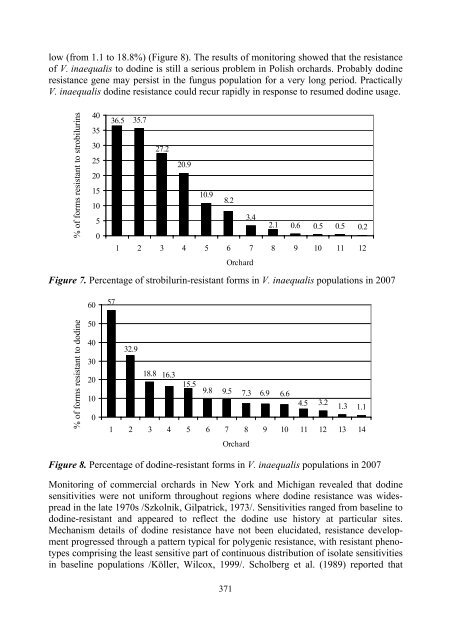Resistance of Venturia inaequalis to strobilurin and dodine
Resistance of Venturia inaequalis to strobilurin and dodine
Resistance of Venturia inaequalis to strobilurin and dodine
You also want an ePaper? Increase the reach of your titles
YUMPU automatically turns print PDFs into web optimized ePapers that Google loves.
low (from 1.1 <strong>to</strong> 18.8%) (Figure 8). The results <strong>of</strong> moni<strong>to</strong>ring showed that the resistance<br />
<strong>of</strong> V. <strong>inaequalis</strong> <strong>to</strong> <strong>dodine</strong> is still a serious problem in Polish orchards. Probably <strong>dodine</strong><br />
resistance gene may persist in the fungus population for a very long period. Practically<br />
V. <strong>inaequalis</strong> <strong>dodine</strong> resistance could recur rapidly in response <strong>to</strong> resumed <strong>dodine</strong> usage.<br />
% <strong>of</strong> forms resistant <strong>to</strong> <strong>strobilurin</strong>s<br />
40<br />
35<br />
30<br />
25<br />
20<br />
15<br />
10<br />
5<br />
0<br />
36.5<br />
35.7<br />
27.2<br />
20.9<br />
10.9<br />
8.2<br />
1 2 3 4 5 6 7 8 9 10 11 12<br />
Orchard<br />
Figure 7. Percentage <strong>of</strong> <strong>strobilurin</strong>-resistant forms in V. <strong>inaequalis</strong> populations in 2007<br />
% <strong>of</strong> forms resistant <strong>to</strong> <strong>dodine</strong><br />
60<br />
50<br />
40<br />
30<br />
20<br />
10<br />
0<br />
57<br />
32.9<br />
18.8 16.3<br />
371<br />
3.4<br />
2.1<br />
15.5 9.8 9.5 7.3 6.9 6.6<br />
0.6<br />
0.5<br />
4.5 3.2<br />
0.5<br />
0.2<br />
1.3 1.1<br />
1 2 3 4 5 6 7 8 9 10 11 12 13 14<br />
Orchard<br />
Figure 8. Percentage <strong>of</strong> <strong>dodine</strong>-resistant forms in V. <strong>inaequalis</strong> populations in 2007<br />
Moni<strong>to</strong>ring <strong>of</strong> commercial orchards in New York <strong>and</strong> Michigan revealed that <strong>dodine</strong><br />
sensitivities were not uniform throughout regions where <strong>dodine</strong> resistance was widespread<br />
in the late 1970s /Szkolnik, Gilpatrick, 1973/. Sensitivities ranged from baseline <strong>to</strong><br />
<strong>dodine</strong>-resistant <strong>and</strong> appeared <strong>to</strong> reflect the <strong>dodine</strong> use his<strong>to</strong>ry at particular sites.<br />
Mechanism details <strong>of</strong> <strong>dodine</strong> resistance have not been elucidated, resistance development<br />
progressed through a pattern typical for polygenic resistance, with resistant phenotypes<br />
comprising the least sensitive part <strong>of</strong> continuous distribution <strong>of</strong> isolate sensitivities<br />
in baseline populations /Köller, Wilcox, 1999/. Scholberg et al. (1989) reported that


